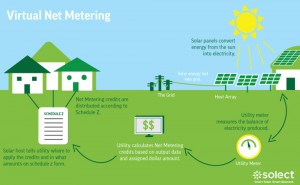
Virtual net metering: Exploring the possibilities for solar energy used off site - by Craig Huntley
As the benefits of solar become better understood, some interesting scenarios and use cases are emerging across Massachusetts and New England. One of those scenarios is virtual net metering.
Net metering is a mechanism that enables solar energy system owners to feed excess electricity back to the grid, and receive a credit for the amount of electricity contributed. For example, if a commercial property owner installs solar on their roof, it may generate more electricity than is used and the electricity meter will run backwards to provide a credit towards their utility bill. Net metering ensures that solar array owners receive a fair value for the energy that is being added to the grid.
Virtual net metering is similar, but with one important caveat: very little if any of the energy is consumed on site by the owner, but is rather fed into the grid and the credit for that energy is allocated to a consumer or consumers off site, but still within the same utility load zone.
Virtual net metering is applicable in scenarios where an organization wants to install solar, but does not have suitable property conditions—small or inappropriate roof, too much shading, etc. for on-site solar. In this case, the organization could benefit from solar through a net metering credit agreement, which allows them to apply the credit generated from an off-site solar array, to their own utility bill. Net metering credit agreements often include a discount for the credited electricity, thus saving the end user money on their bill.
In a reverse scenario, an organization that has the perfect site for solar but does not have a large enough energy demand (or no demand at all) would install solar on their site and receive a credit for the electricity generated and “sold” back to the grid. That solar array owner could then sell that credit through a net metering credit agreement to a property owner who has a demand for energy in the same load zone, but is unable to install solar on-site.
Let’s take a look at a common example of virtual net metering in action. A solar developer or installer uses its own land or rooftop, or leases land or a large rooftop from a property owner. This could be a warehouse or distribution facility, a parking lot, or other location that has suitable conditions for solar (i.e., plenty of sun exposure, facing in a southerly direction, etc.) but consumes very little electricity or does not have a need for on-site power. The energy produced from the solar energy system is fed into the grid where the credit for that energy accumulates on the meter associated with the property and is then allocated to an off-site consumer in the same utility load zone, such as communities, non-profits, organizations or residents.
Community solar projects are a great example of virtual net metering in action. For these projects, energy is produced at an off-site solar array and then purchased by cities or towns to power such entities as a school, town hall, police station or other facilities, or is used by homeowners, condo owners, and others to offset their existing electric bill. In another scenario, a company’s solar energy system may produce more electricity than they need on-site, so they donate the value of that energy or a net metering credit to another company, such as a non-profit.
Local policy can affect the amount of virtual net metering allowed in specific utility territories, and there are a lot of moving parts to these projects. An experienced solar developer with expertise in solar policy (particularly as it relates specifically to virtual net metering), financing and development, can help walk you through the process and explain the benefits for your specific circumstance.
Craig Huntley is a founding principal and CDO of Solect Energy, Hopkinton, Mass.
